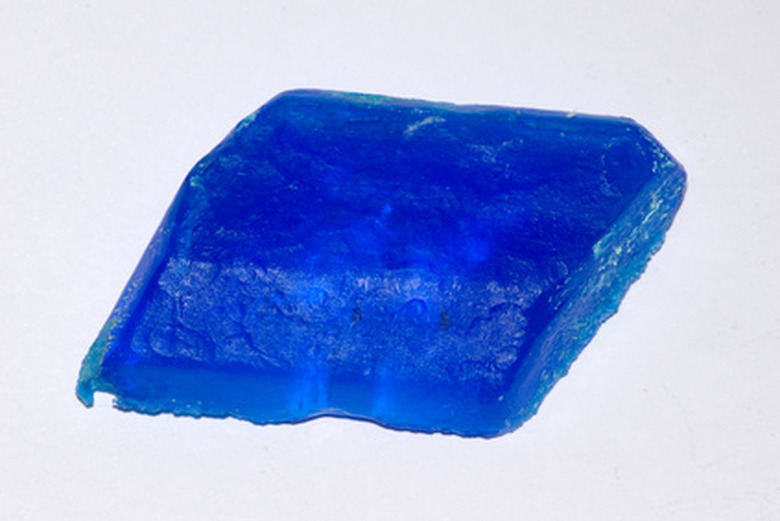How To Make A Copper Sulfate Solution
Copper sulfate is a chemical compound with the formula CuSO4 and can be made in a chemistry laboratory by reacting copper oxide with sulphuric acid. Copper sulfate has many uses, from a fungicide and herbicide in agriculture, to creating the vivid blue colors in fireworks or for use in copper plating. Copper sulfate is acidic and should be handled with care due to its toxicity. Although a common component in school science lessons, students should be carefully supervised when working with copper sulfate solution.
Step 1
Put on safety goggles, and place the Bunsen burner on a heat-proof mat underneath a tripod. Check that the air hole on the Bunsen burner is fully closed, and turn on the gas tap. Light a splint and hold it two inches over the top of the Bunsen burner to ignite the gas.
Step 2
Pour 20 cm3 of the dilute sulphuric acid into the beaker. Open the air hole on the Bunsen burner to give a blue flame, and place the beaker on the tripod. Heat the sulphuric acid until almost boiling.
Step 3
Add a small amount of the copper oxide powder into the beaker using a spatula. Stir the mixture for 30 seconds with the glass stirring rod. Repeat until one gram of copper oxide powder has been added.
Step 4
Continue to heat for another two minutes to ensure the reaction has completed. Turn off the Bunsen burner and allow the beaker to cool slightly.
Step 5
Place a funnel in the conical flask, and fold a filter paper to fit the funnel. Swirl the beaker gently to ensure the contents of the solution are mixed, then pour the solution slowly through the filter paper. This step removes any unreacted copper oxide remaining. Clear blue copper sulfate solution will be left in the flask. If there are any impurities remaining in the solution, repeat the filter process.
Things Needed
- Dilute sulfuric acid, 0.5 mol dm-3
- Copper(II) oxide, 1 gram
- Glass beaker
- Conical flask
- Spatula
- Glass stirring rod
- Filter funnel and filter paper
- Bunsen burner
- Heatproof mat
- Safety goggles
TL;DR (Too Long; Didn't Read)
The chemical equation for the reaction is:
CuO(s) + H2SO4(aq) -> CuSO4(aq) + H2O(l)
The copper oxide and sulphuric acid react to form copper sulfate and water.
Warning
Always wear safety goggles to protect your eyes. If any copper sulfate solution comes in contact with skin, it should be washed off immediately with water. Be careful when pouring the solution from the beaker into the conical flask because the beaker will be hot.
Cite This Article
MLA
Downes-Powell, Gareth. "How To Make A Copper Sulfate Solution" sciencing.com, https://www.sciencing.com/make-copper-sulfate-solution-7834930/. 24 April 2017.
APA
Downes-Powell, Gareth. (2017, April 24). How To Make A Copper Sulfate Solution. sciencing.com. Retrieved from https://www.sciencing.com/make-copper-sulfate-solution-7834930/
Chicago
Downes-Powell, Gareth. How To Make A Copper Sulfate Solution last modified March 24, 2022. https://www.sciencing.com/make-copper-sulfate-solution-7834930/
